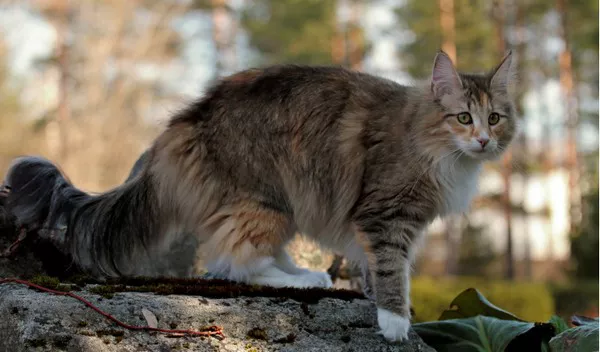In the realm of feline companionship, certain breeds stand out for their unique characteristics, and the Norwegian Forest Cat is undoubtedly one of them. Known for their striking appearance and fascinating history, these majestic cats have garnered a reputation that often leaves enthusiasts wondering: Are Norwegian Forest Cats rare? In this article, we will delve into the origins, characteristics, and current status of the Norwegian Forest Cat to unravel the mystique surrounding this captivating breed.
Origins and History
To understand the rarity of Norwegian Forest Cats, it’s essential to explore their origins. This ancient breed has a rich history rooted in Norse mythology and Norwegian folklore. Referred to as “Skogkatt” in Norway, which translates to “forest cat,” these felines were believed to have been companions to the Norse goddess Freyja, the goddess of love and fertility.
The Norwegian Forest Cat’s history extends back centuries, with tales of their prowess as mousers on Viking ships and their adaptation to the harsh Nordic climate. Despite their longstanding presence in Norwegian culture, it wasn’t until the 20th century that efforts were made to preserve and promote the breed.
Characteristics of Norwegian Forest Cats
Physical Appearance
Norwegian Forest Cats are renowned for their distinctive physical features. They are large, robust cats with a strong bone structure and muscular build. Their long, bushy tails, tufted ears, and almond-shaped eyes give them an almost wild appearance. The semi-longhair coat, adorned with a thick, water-resistant top layer and a soft undercoat, serves as protection against the harsh Scandinavian weather.
Temperament
Beyond their striking appearance, Norwegian Forest Cats are known for their friendly and gentle nature. These cats are often described as social, intelligent, and good with children and other pets. Their adaptability makes them suitable for various living environments, from cozy homes to spacious estates.
Grooming Needs
The luxurious coat of Norwegian Forest Cats requires regular grooming to prevent matting and reduce shedding. Despite their thick fur, they are surprisingly low-maintenance in terms of grooming, as their coat lacks the fine undercoat that many other long-haired breeds possess.
Rarity Factors
Breed Popularity
The rarity of Norwegian Forest Cats can be influenced by their popularity within the feline community. While the breed has gained recognition and admiration worldwide, it remains less common compared to more widely popular breeds like the Persian or Siamese. The limited number of Norwegian Forest Cats available for adoption or purchase contributes to their perceived rarity.
Breeding Practices
Breeding practices play a pivotal role in determining the prevalence of a particular cat breed. Norwegian Forest Cats require careful breeding to maintain their distinct characteristics. Responsible breeders adhere to breed standards, emphasizing traits such as coat quality, color patterns, and overall health. Due to their specific needs, breeding Norwegian Forest Cats can be more challenging, contributing to their relative rarity.
Conservation Efforts
In recent years, increased awareness of the importance of preserving rare and ancient breeds has led to conservation efforts for the Norwegian Forest Cat. Dedicated breeders, cat fancier associations, and enthusiasts work collaboratively to ensure the breed’s continued existence and promote responsible breeding practices. These conservation efforts aim to strike a balance between maintaining breed purity and avoiding overbreeding.
Current Status of Norwegian Forest Cats
Adoption Trends
The demand for Norwegian Forest Cats has risen in recent years, fueled by their enchanting appearance and amiable personalities. However, the limited availability of these cats, coupled with responsible breeding practices, has resulted in a controlled market. Potential owners often find themselves on waiting lists or searching extensively to find a reputable breeder.
See Also:Why are norwegian forest cats called fairy cats?
Recognition by Cat Fancier Associations
The recognition of a cat breed by prominent cat fancier associations can impact its perceived rarity. The Norwegian Forest Cat has gained recognition by major cat registries, including The International Cat Association (TICA) and the Cat Fanciers’ Association (CFA). This acknowledgment enhances the breed’s status and encourages responsible breeding practices.
Health Considerations
While the Norwegian Forest Cat is generally a healthy breed, it is not without its specific health considerations. Responsible breeding practices include screening for genetic conditions, such as hypertrophic cardiomyopathy (HCM) and kidney disease. These precautions contribute to the overall health and well-being of the breed, but they also limit the availability of Norwegian Forest Cats in the breeding pool.
Conclusion
In conclusion, the question of whether Norwegian Forest Cats are rare is multifaceted. Their unique history, distinctive characteristics, and the conscientious efforts of breeders and enthusiasts contribute to their perceived rarity. While the breed has gained popularity in recent years, it remains less common than some of its feline counterparts.
The enchanting allure of Norwegian Forest Cats lies not only in their majestic appearance but also in the careful preservation of their cultural and genetic heritage. As the demand for these captivating cats continues to grow, it is imperative to maintain a balance between their popularity and responsible breeding practices, ensuring the longevity and well-being of this extraordinary feline breed.
Related Topics:
Do norwegian forest cats like to cuddle?
When do norwegian forest cats stop growing?
What is the average lifespan of a norwegian forest cat?


























